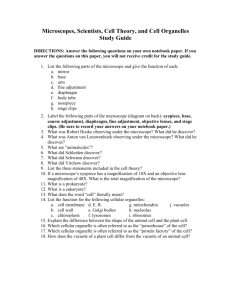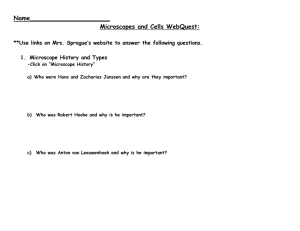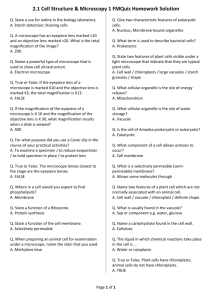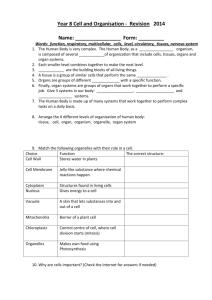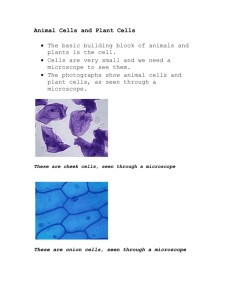Microscopes, Cells, & Organelles Study Guide
advertisement
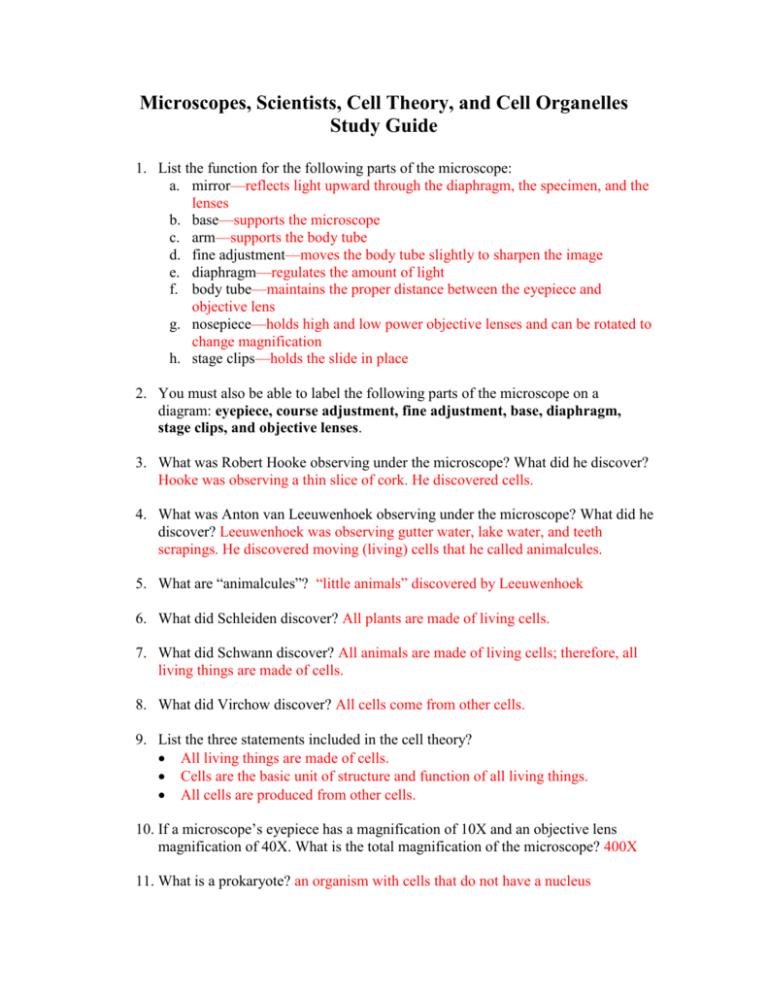
Microscopes, Scientists, Cell Theory, and Cell Organelles Study Guide 1. List the function for the following parts of the microscope: a. mirror—reflects light upward through the diaphragm, the specimen, and the lenses b. base—supports the microscope c. arm—supports the body tube d. fine adjustment—moves the body tube slightly to sharpen the image e. diaphragm—regulates the amount of light f. body tube—maintains the proper distance between the eyepiece and objective lens g. nosepiece—holds high and low power objective lenses and can be rotated to change magnification h. stage clips—holds the slide in place 2. You must also be able to label the following parts of the microscope on a diagram: eyepiece, course adjustment, fine adjustment, base, diaphragm, stage clips, and objective lenses. 3. What was Robert Hooke observing under the microscope? What did he discover? Hooke was observing a thin slice of cork. He discovered cells. 4. What was Anton van Leeuwenhoek observing under the microscope? What did he discover? Leeuwenhoek was observing gutter water, lake water, and teeth scrapings. He discovered moving (living) cells that he called animalcules. 5. What are “animalcules”? “little animals” discovered by Leeuwenhoek 6. What did Schleiden discover? All plants are made of living cells. 7. What did Schwann discover? All animals are made of living cells; therefore, all living things are made of cells. 8. What did Virchow discover? All cells come from other cells. 9. List the three statements included in the cell theory? All living things are made of cells. Cells are the basic unit of structure and function of all living things. All cells are produced from other cells. 10. If a microscope’s eyepiece has a magnification of 10X and an objective lens magnification of 40X. What is the total magnification of the microscope? 400X 11. What is a prokaryote? an organism with cells that do not have a nucleus 12. What is a eukaryote? an organism with cells that do have a nucleus 13. What does the word “cell” literally mean? small room or chamber 14. List the function for the following cellular organelles: a) cell membrane—controls what enters and leaves the cell b) cell wall—protects and supports the cell c) chloroplasts—captures sun’s energy and uses it to make food d) E. R.—passageway for proteins e) Golgi bodies—receives proteins from E.R., packages and redistributes them f) lysosomes—chemicals that break down materials in the cell g) mitochondria—converts food energy to usable energy h) nucleolus—produces ribosomes i) ribosomes—produce proteins j) vacuoles—stores food and/or waste 15. Explain the difference between the shape of the animal cell and the plant cell. The animal cell typically has a round shape, while the plant cell has more of a square/rectangle shape. 16. Which cellular organelle is often referred to as the “powerhouse” of the cell? mitochondria 17. Which cellular organelle is often referred to as the “protein factory” of the cell? ribosomes 18. How does the vacuole of a plant cell differ from the vacuole of an animal cell? Plant cells have one large vacuole, and animal cells have several small vacuoles.
